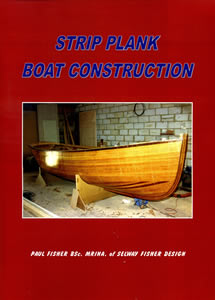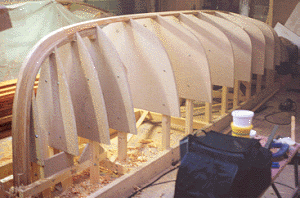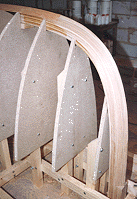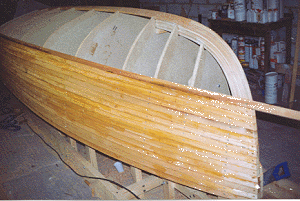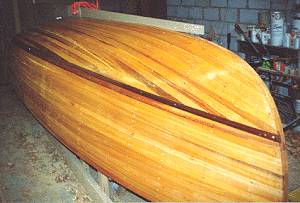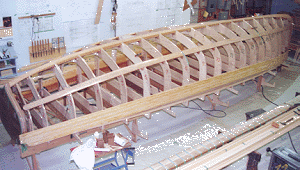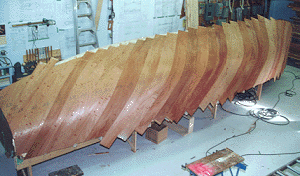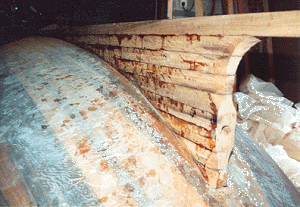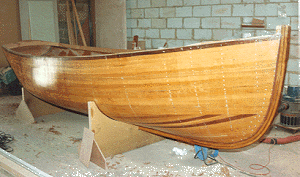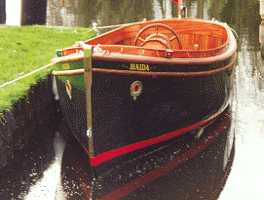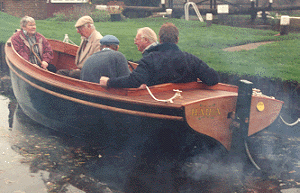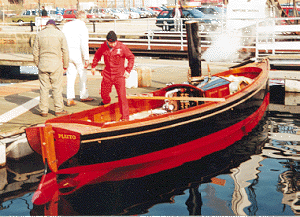 |
|
CONSTRUCTING A STRIP PLANKED BOAT |
|
INTRODUCTION Many boat builders, both amateur and professional, would like to build a lovely round bilged boat but the skills and tools required to achieve this have often precluded such a boat from being attempted. Traditionally, the hull shape has had to be "lofted" (drawn down full size) and faired so that the frame or mould shapes could be accurately taken off the lofting. The frames or moulds were then erected on a strongback with the keel member etc and then the solid planking added - the planks had to be carefully tapered towards the ends and then the seams were "caulked". This is the traditional "Carvel" method of boat construction. Today, we can produce a lovely round bilged shape without many of the tools and skills required for traditional round bilged construction by using the strip planked method. Basically this method entails marking and cutting out mould (sectional) shapes from a cheap material like chipboard and erecting these upside down on a simple strongback. The hog (internal wood keel), stem and transom are then positioned onto the strongback (and also sometimes the bilge stringers and inwale may also be added). Some of the moulds may be substituted with permanent ply bulkheads. Once this "jig" is completed, the edges of the moulds, hog etc are beveled to suit the planking which is in the form of narrow parallel strips of wood - usually Cedar. The Cedar strips are temporarily fastened to the moulds but permanently glued to the hog, stem, transom etc and to each other. Once the hull has been covered with the Cedar strips, the Cedar is cleaned up and then sheathed. Cedar is quite soft and therefore needs sheathing whilst other timbers may not. The sheathing is often woven glass cloth in epoxy resin which allows the natural wood to show through and gives the Cedar a protective hard outer surface. Alternatively, the Cedar may be overlaid with wood veneers often laid diagonally. Skegs and outer wood keels etc may then be added before the hull is released from the jig/strongback and turned over. Once up the right way the inside of the hull is cleaned up and may be sheathed. What you now have is a hull "shell" which is much lighter than a conventional carvel planked hull but just as strong and ready for fitting out. The advantages of this
method, apart from the fact that you end up with a beautiful round bilged hull,
are lower cost, weight and time when compared with traditional carvel
construction and the need for less skills and tools.
|
|
|
THE STRIP PLANK METHOD OF CONSTRUCTION For this, we will use several different Selway Fisher Designs as examples but mainly the 17'9" INDIAN RUNNER steam launch.
A. The chipboard moulds (sectional shapes) are carefully erected onto a simple wood strongback.
B. In this case, the internal stem has been laminated but may be made up from solid wood - note the hog which is laminated in situ on the moulds.
C. Planking starts - in this case from the gunwale until bending the wood strips becomes too difficult - in some cases, depending on the hull shape, you can plank right from the gunwale up to the hog.
D. In this case, planking was stopped at the bilge and then started again from the hog to meet the previous planking - this means that some of the strips have to be tapered at their ends. If the builder prefers - to make sure that the planking can be done without the need to stop and change direction - the first plank can be positioned at the bilge and allowed to lay along the "great circle" route - planking then continues above and below this first plank.
E. In some designs, other internal items are fitted before the hull is planked - in this example, a bilge stringer has been laminated in situ on one of our 25'6" Snow Bunting designs.
F. Once planking is complete and cleaned up the hull is sheathed in glass cloth or wood veneer.
G. External wood keels/skegs can be laminated on the hull whilst it is still upside down, cleaned up off the boat and then refitted before the hull is turned over - the example above is one of our Edwardian 26's.
H. The hull with stem etc laminated over the glass sheathing and turned upright.
I. The finished boat - above the 17'9" Indian Runner and below the 25'6" Snow Bunting.
For a detailed explanation of the strip plank process see our MANUAL OF STRIP PLANK CONSTRUCTION TECHNIQUES |
